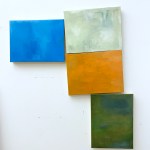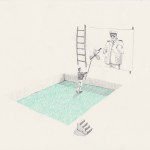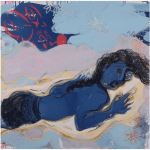Known primarily as a Precisionist painter, Elsie Driggs (1898-1992), in the course of her long career, also painted still life and the figure. After studying at the Art Students League and in Italy, she settled in New York City, where she enjoyed immediate success. During the 1920s Driggs became associated with the Precisionists, also known as New Classicists or Immaculates, a group that painted the modern landscape of factories, bridges, and skyscrapers with geometric precision and almost abstract spareness. After marrying painter Lee Gatch, whose work she admired, Driggs moved to Lambertville, New Jersey in 1935 and devoted herself primarily to supporting her husband’s career, a choice many female artists of her generation made.
In the Philadelphia Inquirer, Edward J. Sozanski reports that Driggs didn’t have a studio during the Lambertville years. “She and Gatch lived in a small house, and he, being the man and having the bigger reputation, got the only studio space. She got the kitchen table, where she painted watercolors. More important, Driggs was never content to belabor a single line of inquiry. Brilliant as she was at precisionism, she was more interested in testing variations on her basic aesthetic formula – classical order and repose tempered with what she described as ‘something happening,’ and which we experience as liveliness or vibrancy. This ‘classical quickness’ is the engine of her creativity. Subject matter and media change through the years, but Driggs’ remarkable ability to impart the quickness of life to inanimate objects and static tableaux remains constant.” Read more.
“Elsie Driggs: The Quick and the Classical,” curated by Connie Kimmerle. James A. Michener Art Museum, Doylestown, PA. Through














